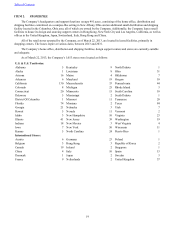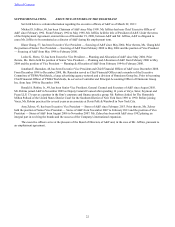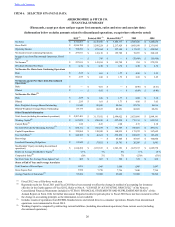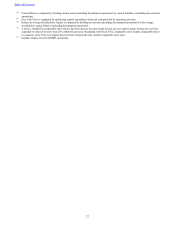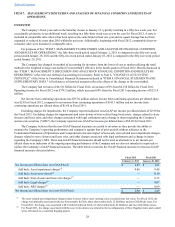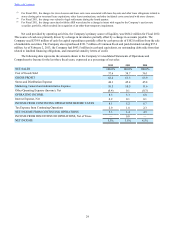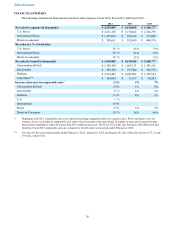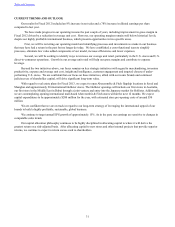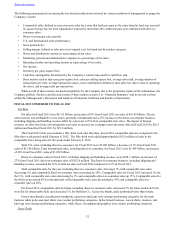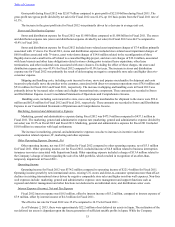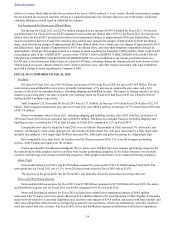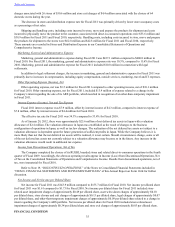Abercrombie & Fitch 2013 Annual Report Download - page 28
Download and view the complete annual report
Please find page 28 of the 2013 Abercrombie & Fitch annual report below. You can navigate through the pages in the report by either clicking on the pages listed below, or by using the keyword search tool below to find specific information within the annual report.
28
ITEM 7. MANAGEMENT’S DISCUSSION AND ANALYSIS OF FINANCIAL CONDITION AND RESULTS OF
OPERATIONS.
OVERVIEW
The Company’s fiscal year ends on the Saturday closest to January 31, typically resulting in a fifty-two week year, but
occasionally giving rise to an additional week, resulting in a fifty-three week year as was the case for Fiscal 2012. A store is
included in comparable sales when it has been open as the same brand at least one year and its square footage has not been
expanded or reduced by more than 20% within the past year. Additionally, beginning with Fiscal 2012, comparable direct-to-
consumer sales were included in comparable sales.
For purposes of this “ITEM 7. MANAGEMENT’S DISCUSSION AND ANALYSIS OF FINANCIAL CONDITION
AND RESULTS OF OPERATIONS,” the fifty-three week period ended February 2, 2013 is compared to the fifty-two week
period ended January 28, 2012 and the fifty-two week period ended January 28, 2012 is compared to the fifty-two week period
ended January 29, 2011.
The Company has changed its method of accounting for inventory from the lower of cost or market utilizing the retail
method to the weighted average cost method ("cost method") effective in the fourth quarter of Fiscal 2012. Results discussed in
this "ITEM 7. MANAGEMENT’S DISCUSSION AND ANALYSIS OF FINANCIAL CONDITION AND RESULTS OF
OPERATIONS," reflect the cost method of accounting for inventory. Refer to Note 4, "CHANGE IN ACCOUNTING
PRINCIPLE," of the Notes to Consolidated Financial Statements included in "ITEM 8. FINANCIAL STATEMENTS AND
SUPPLEMENTARY DATA." All references to historical amounts reflect the effects of the change to the cost method.
The Company had net sales of $4.511 billion for Fiscal 2012, an increase of 8% from $4.158 billion for Fiscal 2011.
Operating income for Fiscal 2012 was $374.2 million, which increased 69% from the Fiscal 2011 operating income of $221.4
million.
Net income from continuing operations was $237.0 million and net income from continuing operations per diluted share
was $2.85 in Fiscal 2012, compared to net income from continuing operations of $143.1 million and net income from
continuing operations per diluted share of $1.60 in Fiscal 2011.
Excluding charges for impairments, the Company reported adjusted, non-GAAP net income per diluted share of $2.90 for
the Fiscal 2012. Excluding charges for impairments and write-downs of store-related long-lived assets, charges related to store
closures and lease exits, and other charges associated with legal settlements and a change in intent regarding the Company’s
auction rate securities ("ARS"), the Company reported non-GAAP net income per diluted share of $2.49 for Fiscal 2011.
The Company believes that the non-GAAP financial measures are useful to investors as they provide the ability to
measure the Company’s operating performance and compare it against that of prior periods without reference to the
Consolidated Statements of Operations and Comprehensive Income impact of non-cash, store-related asset impairment charges,
charges related to store closures and lease exits, and other charges associated with legal settlements and a change in intent
regarding the Company's ARS. These non-GAAP financial measures should not be used as alternatives to net income per
diluted share or as indicators of the ongoing operating performance of the Company and are also not intended to supersede or
replace the Company’s GAAP financial measures. The table below reconciles the GAAP financial measures to the non-GAAP
financial measures discussed above.
Fiscal 2012 Fiscal 2011
February 2, 2013 January 28, 2012
Net income per diluted share on a GAAP basis $ 2.85 $ 1.61
Add back: Asset impairment charges(1) 0.06 0.49
Add back: Asset write-downs(2) — 0.10
Add back: Store closure and lease exit charges(3) — 0.13
Add back: Legal charges(4) — 0.07
Add back: ARS charges(5) — 0.09
Net income per diluted share on a non-GAAP basis $ 2.90 $ 2.49
(1) The store-related asset impairment charges relate to stores whose asset carrying value exceeded their fair value. For Fiscal 2012, the
charge was primarily associated with one Abercrombie & Fitch, three abercrombie kids, 12 Hollister and one Gilly Hicks store. For
Fiscal 2011, the charge was associated with 14 Abercrombie & Fitch, 21 abercrombie kids, 42 Hollister and two Gilly Hicks stores.
(2) For Fiscal 2011, the charge associated with the asset write-downs was related to the reconfiguration of three flagship stores and a small
write-off related to a cancelled flagship project.
Table of Contents



